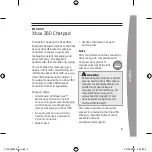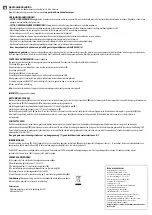
6-1
Chapter 6
–
Interfacing to Other Equipment
Interfacing the CAT-800 to your repeater system is a simple matter. A minimum of two inputs, two
outputs and a ground are required for the CAT-800 to control a repeater. They are:
1.
A COR signal from the repeater’s receiver to indicate that a signal is being received.
2.
A receive audio signal containing DTMF tones to be processed for control of the CAT-800.
3.
A Push-To-Talk signal from the CAT-80
0 to tell the repeater’s transmitter to turn ON.
4.
A transmit audio signal containing a combination of receive audio, synthesized voice, and
courtesy tones to modulate the transmitter.
5.
A ground wire to connect the chassis of the repeater to ground on the CAT-800.
NOTE: Additional connections may be required to realize all the features of the CAT-800.
Connection to Repeater Transmitter
Locate the repeater Push-To-Talk input. When grounded, this line will make the repeater transmit.
Connect the PTT #1 output (J1-10) to this line. Locate the TX audio input. This is the line were the
audio signal used to modulate the transmitter is applied. Connect the TX1 audio (J1-11) to this input.
Connection to Repeater Receiver
Locate the repeater receiver audio output and connect it to J1-13. Locate the repeater COR and connect
it to J1-
6. Verify the COR line changes from less than 0.2VDC to greater than 3.0 VDC “active high
logic” or from greater than 3.0VDC too less than 0.2VDC “active low logic”. If there i
s no voltage
present this could be an indication the receiver COR circuit is an open collector switch and requires a
pull-up resistor. The CAT-800 has a built in pull-up resistor for Port #1 COR. Set dipswitch #1 to on
because COR #1 is considered active
low. If the repeater’s COR output is 0 VDC and goes above 3VDC
when a signal is being received this is considered an active high COR. Dipswitch should be in the off
position and you should remove the COR #1 jumper plug located behind the 25 pin “D” conn
ector. For
proper operation the Port #1 green COR LED will indicate the CAT-800 is receiving a proper COR signal.
When the repeater is receiving a signal the green COR led should be on and when no signal is being
received the led should be off. Do no continue until this condition is met.
Connection to CTCSS Decoder
If your repeater has a CTCSS decoder output or you are using an external CTCSS decoder like the TS-64
connect the CTCSS logic output to J1-
4. The default setting for this input is “active high logic”. If the
decoder logic output is active low use the [*3612] programming command to change the controller to
accept an “active low logic” input. You can also change from (COR and CTCSS) to (COR or CTCSS)
mode with the [*3613], [*3614] programming commands.
Check PTT and COR Activity
When power is applied the CAT-800 will key-up the transmitter, the voice will say CAT-800 and
announce the firmware version and turn the transmitter off. If this occurs PTT and TX AUDIO are
connected correctly. If this does not occur do not continue until this problem is resolve. If you hear the
message but the transmitter remains on, the COR polarity dipswitch #1 is most likely in the wrong
position. Change the setting of the dipswitch. You should hear the courtesy tone followed by a four
second hang time and the transmitter should turn off.
Check DTMF Decode Activity
Once the COR is resolved the next step is to check DTMF tone decoding. Key-up and enter a DTMF tone.
Adjust RX1 control (R21) for 220mVAC at RX1 test point. Check each tone and verify the amber led
lights. If there is a distortion problem the first tones to not decode are the [3] and [A]. Verify the
repeater receiver and radio used to send the tones are on frequency. If the frequency is off by just a
few KHz, inter-mod distortion may cause a DTMF decode problem. If the DTMF tone is not distorted the
decoder should function with a level as low as 70mVAC. However adjust the level to 220mVAC to insure
user radios with various levels of deviation will decode. If you experience a DTMF decode problem do
not continue until the problem is resolved.
Summary of Contents for CAT-800
Page 42: ...5 13 3634 SET PORT 3 CTCSS LOGIC COR OR CTCSS ACTIVE LO...
Page 87: ...11 1 Chapter 11 Drawings CAT 800 Repeater Controller Board...
Page 88: ...11 2 DR 800 Digital Audio Player...
Page 90: ...12 2 CAT 800 Sheet 1 of 4...
Page 91: ...12 3 CAT 800 Sheet 2 of 4...
Page 92: ...12 4 Sheet 3 of 4...
Page 93: ...12 5 Sheet 4 of 4...
Page 94: ...12 6 DR 800 Digital Audio WAV Player Sheet 1 of 1...
















































